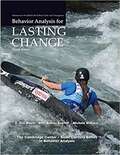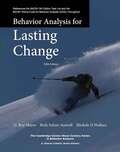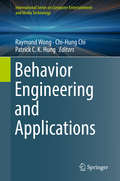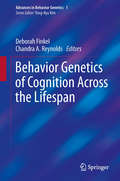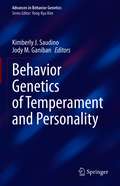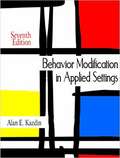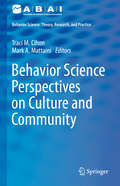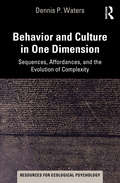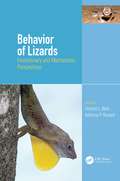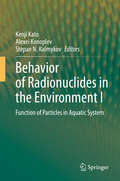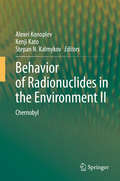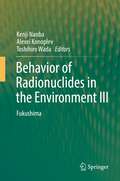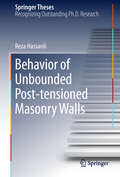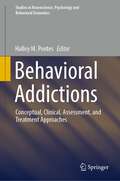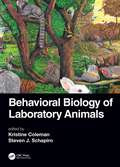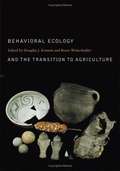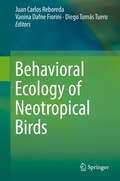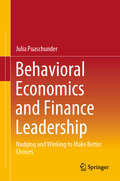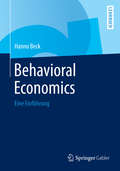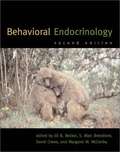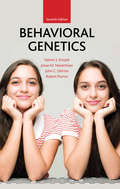- Table View
- List View
Behavior Analysis for Lasting Change
by Michele Wallace Beth Sulzer-Azaroff G. Roy MayerBehavior Analysis for Lasting Change
Behavior Analysis for Lasting Change
by Michele Wallace Beth Sulzer-Azaroff G. Roy MayerBehavior Analysis for Lasting Change
Behavior Engineering and Applications (International Series on Computer Entertainment and Media Technology)
by Chi-Hung Chi Raymond Wong Patrick C. HungMany industrial applications built today are increasingly using emerging behavior engineering technologies: this book looks at various research and practical issues for researchers and students working in computer science and engineering, and for industry technology providers interested in behavior engineering and applications. Behavior Engineering and Applications encompasses intelligent and efficient computational solutions, including models, architectures, algorithms and specific applications, focused on processing, discovering, understanding and analyzing the behavior captured by the above data. Focusing on applying any engineering paradigm to systemically process, discover, understand and analyze these data, this book also addresses problems in a variety of areas and applications that related to behavior engineering.This book includes chapters derived from selected papers from The 2016 International Conference on Behavior Engineering (ICBE), as well as separate contributions the editors selected cutting-edge research related to behavior engineering.
Behavior Genetics of Cognition Across the Lifespan (Advances in Behavior Genetics #1)
by Deborah Finkel Chandra A. ReynoldsAlong with psychopathology, cognition has been one of the primary phenotypic focal points of the field of behavior genetics since its inception. Francis Galton's 1874 examination of eminent families in Britain was among the earliest attempts to investigate whether cognitive achievements run in families. This volume presents current methodologies for understanding cognitive abilities that move beyond the outdated nature vs. nurture paradigm. Recent advances in both collection and statistical modeling of twin data, particularly longitudinal twin data, make this an especially advantageous moment to produce a work that presents a collection of the groundbreaking research on cognitive abilities across the lifespan. This volume presents an overview of the current state of quantitative and molecular genetic investigations into the many facets of cognitive performance and functioning across the lifespan.
Behavior Genetics of Psychopathology (Advances in Behavior Genetics #2)
by Soo Hyun Rhee Angelica RonaldAs a dynamic, interdisciplinary field, behavior genetics and its evolution are being followed closely by scientists across the psychological and medical domains. The discoveries surrounding the human genome and the advancement in molecular genetic technologies have led to studies becoming increasingly sophisticated and yielding yet more conclusive and useful results. This is certainly the case in the area of child and adult psychopathology. Behavior Genetics of Psychopathology summarizes the state of the field, examining the role of genes and environment as they affect common neurodevelopmental and psychiatric conditions. Emphasizing key research areas (comorbidities, twin studies, the integration of methods), the book assesses the current literature, offers up-to-date findings, sorts through lingering controversies, and identifies a clear future agenda for the field. Expertly-written chapters focus on issues of both general salience that shape behavior genetics of psychopathology, to specific disorders of major clinical importance, among them: ADHD: the view from quantitative genetic research. Autism spectrum disorders and their complex heterogeneity Genetic influences on anxiety and depression in childhood and adolescence. Evidence for etiologically-defined subgroups within the construct of antisocial behavior. Sleep and psychopathology: the reasons for their co-occurrence. Behavioral genetic approaches to the etiology of comorbidity. Epigenetics of psychopathology. This combination of timeliness and depth of coverage make Behavior Genetics of Psychopathology a frontline resource for behavior geneticists, psychologists, psychiatrists, and neuroscientists, and is perfectly suited to graduate students looking to join these fields.
Behavior Genetics of Temperament and Personality (Advances in Behavior Genetics)
by Kimberly J. Saudino Jody M. GanibanThis volume examines behavioral genetic research on temperament and personality from a number of perspectives. It takes a developmental perspective on a number of issues across the lifespan, focusing on personality and temperament. The first section focuses on the development of temperament and personality. Typically this has involved exploring genetic and environmental contributions to phenotypic stability and instability, but more recently there has been research that examines the etiology of intra-individual change/growth trajectories. The second section examines genetic and environmental contributions to the association between temperament and personality and other behaviors. The third and fourth sections discuss genotype-environment correlations and interactions, and introduces the reader to molecular genetics research on temperament and personality. Chapter 11 will discuss the significance of this type of research and Chapter 12 will provide an example of specific line of research exploring genes associated with temperament.
Behavior Modification in Applied Settings
by Alan E. KazdinContinuing the tradition of excellence established in previous editions, distinguished researcher, practitioner, and educator Alan Kazdin integrates pioneering and recent research with discussions and examples for altering behavior and the conditions that influence their effectiveness. he Seventh Edition reflects several developments within the field of behavior modification, without diminishing an essential emphasis on applied research and intervention techniques.
Behavior Science Perspectives on Culture and Community (Behavior Analysis: Theory, Research, and Practice)
by Traci M. Cihon Mark A. MattainiAll science proceeds by progressively building on the work of others while remaining open to new discoveries and challenging existing conceptual frameworks. The same is true of culturo-behavior science.This textbook presents the scientifically rigorous work of the last several decades that has taken a behavior-analytic view of social and cultural processes, with an eye for contributions that address social and cultural issues. The chapters herein explore and elaborate on the history, theories, and methodologies of culturo-behavior science and those of its researchers and practitioners. Throughout this volume, the authors intentionally prompt students to both learn from and question the current theory and methods while shaping their own research and practice.This book presents multiple intersecting perspectives intended for graduate-level students of behavior analysis. Contributors to this volume include many of the major scholars and practitioners conducting research and/or practicing in communities and larger cultural systems. Their work is scientifically guided, systemic, and ecologically valid; it includes basic research as well as efforts having applications in community health, sustainability, environmental issues, and social justice, among other matters. There is material here to support specialists preparing to do research or practice within community and cultural-level systems. As well, students who intend to do direct and clinical work will find the background they need to make contributions to the field as engaged, informed citizens.
Behavior and Culture in One Dimension: Sequences, Affordances, and the Evolution of Complexity (Resources for Ecological Psychology Series)
by Dennis P. WatersBehavior and Culture in One Dimension adopts a broad interdisciplinary approach, presenting a unified theory of sequences and their functions and an overview of how they underpin the evolution of complexity. Sequences of DNA guide the functioning of the living world, sequences of speech and writing choreograph the intricacies of human culture, and sequences of code oversee the operation of our literate technological civilization. These linear patterns function under their own rules, which have never been fully explored. It is time for them to get their due. This book explores the one-dimensional sequences that orchestrate the structure and behavior of our three-dimensional habitat. Using Gibsonian concepts of perception, action, and affordances, as well as the works of Howard Pattee, the book examines the role of sequences in the human behavioral and cultural world of speech, writing, and mathematics. The book offers a Darwinian framework for understanding human cultural evolution and locates the two major informational transitions in the origins of life and civilization. It will be of interest to students and researchers in ecological psychology, linguistics, cognitive science, and the social and biological sciences.
Behavior and Culture in One Dimension: Sequences, Affordances, and the Evolution of Complexity (Resources for Ecological Psychology Series)
by Dennis WatersBehavior and Culture in One Dimension adopts a broad interdisciplinary approach, presenting a unified theory of sequences and their functions and an overview of how they underpin the evolution of complexity.Sequences of DNA guide the functioning of the living world, sequences of speech and writing choreograph the intricacies of human culture, and sequences of code oversee the operation of our literate technological civilization. These linear patterns function under their own rules, which have never been fully explored. It is time for them to get their due. This book explores the one-dimensional sequences that orchestrate the structure and behavior of our three-dimensional habitat. Using Gibsonian concepts of perception, action, and affordances, as well as the works of Howard Pattee, the book examines the role of sequences in the human behavioral and cultural world of speech, writing, and mathematics. The book offers a Darwinian framework for understanding human cultural evolution and locates the two major informational transitions in the origins of life and civilization. It will be of interest to students and researchers in ecological psychology, linguistics, cognitive science, and the social and biological sciences.
Behavior of Lizards: Evolutionary and Mechanistic Perspectives
by Anthony Russell Vincent BelsKey features: Presents a contemporary snapshot of the mechanisms underlying the evolution and adaptation of behavior Explores how genetics, epigenetics, development, and environment shape behavior Discusses a broad range of behavioral repertoires and responses, including those related to thermoregulatory, foraging, predatory, displaying, social and escape strategies. Examines physiological and sensory mechanisms Covers the effects of various aspects of global change on behavior, with chapters that focus on the impacts of climate change on hydroregulatory behavior and behavioral responses to the effects of habitat alteration resulting from human-mediated change and colonization by invasive species. Lizards serve as focal organisms for many of biological questions related to evolution, ecology, physiology, and morphology. They are studied at multiple spatial and temporal scales, from the individual to the community level. This book, authored by expert contributors from around the world, explores behaviors underlying the evolution and adaptation of these organisms. It covers conceptual, empirical, and methodological approaches to the understanding of the role that natural and sexual selection play in molding the behavioral traits of lizards. This thorough, illustrated reference should stimulate discussion of the conceptual and methodological approaches for studying the behavioral traits of these fascinating and highly diverse vertebrates.
Behavior of Radionuclides in the Environment I: Function of Particles in Aquatic System
by Stepan N. Kalmykov Kenji Kato Alexei KonoplevThe 3-volume set highlights the behavior of radionuclides in the environment and focusing on the development of related fields of study, including microbiology and nanoscience. In this context, it discusses the behavior of radionuclides released in areas of Lake Karachai in Ural, and those released as a result of Chernobyl accident (1986), and in Fukushima (2011). Volume I presents the experiences gained in South Urals (“Mayak” plant, Lake Karachai), providing a scientific basis for more precise understanding of the behavior of radionuclides in complex subsurface environments. On the basis of monitoring data, it examines the pathways of radionuclide migration and the influence of the geological environment and groundwater on the migration, with a particular focus on particles from the nanoscale to microscale. It also discusses the function of microbes and microscale particles, from their direct interaction with radionuclides to their ecological role in changing the physic-chemical condition of a given environment. Lastly, the protective properties of geological media are also characterized, and mathematical modeling of contaminant migration in the area of Lake Karachai is used to provide information regarding the migration of radionuclides.
Behavior of Radionuclides in the Environment II: Chernobyl
by Stepan N. Kalmykov Kenji Kato Alexei KonoplevThis is Volume II in a three-volume set on the Behavior of Radionuclides in the Environment, focusing on Chernobyl. Now, so many years after the Chernobyl accident, new data is emerging and important new findings are being made. The book reviews major research achievements concerning the behavior of Chernobyl-derived radionuclides, including their air transport and resuspension, mobility and bioavailability in the soil-water environment, vertical and lateral migration in soils and sediments, soil-to-plant and soil-to-animal transfer, and water-to-aqueous biota transfer. The long-term dynamics of radionuclides in aquatic ecosystems are also discussed, in particular, the heavily contaminated cooling pond of the Chernobyl Nuclear Power Plant, which is in the process of being decommissioned. Lessons learned from long-term research on the environmental behavior of radionuclides can help us understand the pathways of environmental contamination, which, in turn, will allow us to improve methods for modeling and predicting the long-term effects of pollution. This book features a wealth of original data and findings, many of which have never been published before, or were not available internationally. The contributing authors are experts from Ukraine, Russia and Belarus with more than 30 years of experience investigating Chernobyl-derived radionuclides in the environment. The content presented here can help to predict the evolution of environmental contamination following a nuclear accident, and specifically the Fukushima Dai-ichi nuclear power plant accident.
Behavior of Radionuclides in the Environment III: Fukushima
by Alexei Konoplev Kenji Nanba Toshihiro WadaThis book, the third in the series Behavior of Radionuclides in the Environment, is dedicated to Fukushima. Major findings from research since 2011 are reviewed concerning the behavior of radionuclides released into the environment due to the Fukushima Dai-ichi Nuclear Power Plant accident, including atmospheric transport and fallout of radionuclides, their fate, and transport in the soil-water environment, behavior in freshwater, coastal and marine environment, transfer in the terrestrial and agricultural environment. Volume III discusses not only radionuclides dynamics in the environment in the short- and mid-term, but also modeling and prediction of long-term time changes.Along with reviews, the book contains original data and results not published previously. It was spearheaded by the authors from the Institute of Environmental Radioactivity at Fukushima University, established two years after the Fukushima accident, with their collaborators from Japan, Russia, and Ukraine. The knowledge emerging from the studies of the environmental behavior of Fukushima-derived radionuclides enables us to move forward in understanding mechanisms of environmental contamination and leads to better modeling and prediction of long-term pollution effects in general.
Behavior of Unbounded Post- tensioned Masonry Walls (Springer Theses)
by Reza HassanliThis book reports on a comprehensive analytical, experimental and numerical study on the flexural response of post-tensioned masonry walls under in-plane loads. It explores an important mechanism in this new generation of structural walls, called “Self-centering”. This mechanism can reduce residual drifts and structural damage during earthquake ground motion, and is particularly favorable for structures which are designed for immediate occupancy performance levels. The book reports on the development and verification of a finite element model of post-tensioned masonry walls. It describes a detailed parametric study to predict the strength of post-tensioned masonry walls. New design methodologies and expressions are developed to predict the flexural strength and force-displacement response of post-tensioned masonry. Experimental study is carried out to better understand the behavior of post-tensioned masonry walls and also to evaluate the accuracy of the proposed design procedure and expressions. The book also includes an introduction to current research on unbounded post-tensioned masonry walls, together with an extensive analysis of previously published test results.
Behavioral Addictions: Conceptual, Clinical, Assessment, and Treatment Approaches (Studies in Neuroscience, Psychology and Behavioral Economics)
by Halley M. PontesThis book provides a holistic evidence-based perspective on conceptual, clinical, assessment, and treatment aspects of key non-substance-based addictive disorders related to: gambling, gaming, social media, smartphone, internet, love, sex, exercise, work, and shopping. Each chapter focuses on a different addictive disorder and is structured in a user-friendly way to enable the reader fast navigation, yet the main aspects of the respective disorders are covered in the necessary depth. All in all, this book offers a timely, self-contained introduction to both key concepts and the latest scientific developments in behavioral addictions. It addresses mental health practitioners, researchers in psychology, neuroscience and communication, and undergraduate and postgraduate students alike.
Behavioral Biology of Laboratory Animals
by Steven J. Schapiro Kristine ColemanThis 30-chapter volume informs students and professionals about the behavioral biology of animals commonly housed in laboratory and other captive settings. Each species evolved under specific environmental conditions, resulting in unique behavioral patterns, many of which are maintained in captivity even after generations of breeding. Understanding natural behavior is therefore a critical part of modern animal care practices. The descriptions, data, guidance, resources, and recommendations in this book will help the reader understand their animals better, refine the care and treatment that they receive, and improve the well-being, welfare, and wellness of their animals. The book is divided into three sections, all focusing on aspects of the behavioral biology of animals found in laboratories and related research settings. After five introductory chapters, 25 chapters are dedicated to specific taxonomic groups (including mice, zebrafish, zebra finches, reptiles, macaques) while a concluding section of ethograms provides a centralized resource for those interested in understanding, and potentially quantifying, animal behavior. The Behavioral Biology of Laboratory Animals will provide anyone working in maintenance, care, and/or research programs that involve laboratory animals with information about the way the animals live in the wild, and the way that they should live in captive research settings. Many of the guidelines and recommendations will also be valuable to those managing and working with animals in other environments, including zoological parks, aquaria, and sanctuaries.
Behavioral Ecology and the Transition to Agriculture
by Douglas J. Kennett Bruce WinterhalderThis innovative volume is the first collective effort by archaeologists and ethnographers to use concepts and models from human behavioral ecology to explore one of the most consequential transitions in human history: the origins of agriculture. Carefully balancing theory and detailed empirical study, and drawing from a series of ethnographic and archaeological case studies from eleven locations--including North and South America, Mesoamerica, Europe, the Near East, Africa, and the Pacific--the contributors to this volume examine the transition from hunting and gathering to farming and herding using a broad set of analytical models and concepts. These include diet breadth, central place foraging, ideal free distribution, discounting, risk sensitivity, population ecology, and costly signaling. An introductory chapter both charts the basics of the theory and notes areas of rapid advance in our understanding of how human subsistence systems evolve. Two concluding chapters by senior archaeologists reflect on the potential for human behavioral ecology to explain domestication and the transition from foraging to farming.
Behavioral Ecology of Neotropical Birds
by Juan Carlos Reboreda Vanina Dafne Fiorini Diego Tomás TueroThis book covers central aspects of behavioral ecology, including sexual selection, social and genetic mating systems, cooperative breeding, brood parasitism, brood reduction, migration, personalities and communication. Over the past several years, Neotropical bird species from temperate to tropical latitudes of South America have been extensively studied, yielding valuable insights into the evolutionary mechanisms that drive their behavioral traits. In this book, international experts provide a general overview of main behavioral aspects. They also present the main findings of their work, including experimental approaches to testing the most accepted behavioral theory in their model systems. In closing, they propose new theoretical frameworks and future research directions. As such, the book provides a comprehensive and updated guide for all researchers, students and professionals whose work involves the study and management of birds across the Neotropical region.
Behavioral Economics and Finance Leadership: Nudging and Winking to Make Better Choices
by Julia PuaschunderThis book explores human decision-making heuristics and studies how nudging and winking can help citizens to make rational choices. By applying the behavioral economics approach to political outcomes, it demonstrates how economics can be employed for the greater societal good. It starts with a review of the current literature on human decision-making failures in Europe and North America, presenting the wide range of nudges and winks developed to curb the harmful consequences of human decision-making fallibility. It then discusses the use of mental heuristics, biases and nudges in the finance domain to benefit economic markets by providing clear communication strategies. Lastly, the author proposes clear leadership and followership directives on nudging in the digital age. This book appeals to scholars and policy makers interested in rational decision-making and the use of nudging and winking in the digital age.
Behavioral Economics: Eine Einführung
by Hanno BeckSeit den siebziger Jahren haben die Erkenntnisse und Forschungen der Psychologie auch Einzug in die Wirtschaftswissenschaften gehalten – sie sollen das Menschenbild der Ökonomen und ihre Modelle realistischer machen. Dieses Buch beschreibt die wichtigsten Methoden, Konzepte und Erkenntnisse der verhaltenswissenschaftlichen Ökonomik (Behavioral Economics) und weitere dazugehörige Forschungsgebiete wie Glücksforschung, Fairness und Neuroökonomie. Das Lehrbuch stellt die wichtigsten theoretischen und empirischen Befunde und Ideen vor, um sie anschließend einer kritischen Würdigung zu unterziehen. Es ist sowohl für Studierende geeignet als auch für Dozenten und Wissenschaftler, die sich über den aktuellen Forschungsstand der Disziplin informieren wollen.
Behavioral Endocrinology (2nd edition)
by Jill B. Becker S. Marc Breedlove David Crews Margaret M. MccarthyThis popular behavioral endocrinology text provides detailed information on what hormones are, how they affect cells, and how such effects can alter the behavior of animals, including humans. Presenting a broad continuum of levels of analysis, from molecular to evolutionary, the book discusses how genes work, the structure of cells, the interactions of endocrine organs, the behavior of individuals, the structure of social hierarchies, and the evolution of mating systems. The second edition, while maintaining the strengths of the first edition, has been thoroughly revised to reflect recent developments in genetics and molecular biology and related social concerns. It contains four new chapters: on the use of molecular biology techniques in behavioral endocrinology, on psychoneuroimmunology, on hormonal influences on sensorimotor function, and on cognitive function in nonhuman animals.
Behavioral Genetics
by Robert Plomin Jenae M. Neiderhiser Valerie S. Knopik John C. DefriesWith its clear and concise presentation, Behavioral Genetics, 7th edition introduces students to the field's underlying principles, defining experiments, ongoing controversies, and most recent discoveries. The text provides students with an understanding of heredity, it's DNA basis, the methods used to discover genetic influence on behavior and identify specific genes. It then examines what is known about genetic influence on cognitive ability, psychopathology, substance abuse, personality, health psychology, and aging. Finally it looks ate the future of the field of Behavioral Genetics and area where some of the most exciting development in the Behavioral sciences are being made.
Behavioral Genetics of the Fly (Drosophila melanogaster)
by Josh DubnauThe common fruit fly - Drosophila melanogaster - has been the subject of genetics research since the early twentieth century. The complete genomic sequence of Drosophila was published in 2000 and it is still the model organism par excellence for the experimental study of biological phenomena and processes. It is also by far the best model for studying gene function in mammals, including humans. Presenting state-of-the-art studies on the behaviour of Drosophila, this volume discusses normal and pathological models of neurobehavioral disorders and encompasses the specialised methods that have been used, from anatomical, histological, immunohistological and neurophysiological to genomic, genetic and behavioural assays. A comprehensive and thorough reference, this volume is a valuable resource for students and researchers alike across several disciplines of life sciences, including behavioral genetics, neurogenetics, behavioral neuroscience, molecular biology, evolutionary biology and population biology.
Behavioral Genetics of the Mouse
by Wim E. Crusio Frans Sluyter Robert T. Gerlai Susanna Pietropaolo Wim E. Crusio Frans Sluyter Robert T. GerlaiThe first volume in the new Cambridge Handbooks in Behavioral Genetics series, Behavioral Genetics of the Mouse provides baseline information on normal behaviors, essential in both the design of experiments using genetically modified or pharmacologically treated animals and in the interpretation and analyses of the results obtained. The book offers a comprehensive overview of the genetics of naturally occurring variation in mouse behavior, from perception and spontaneous behaviors such as exploration, aggression, social interactions and motor behaviors, to reinforced behaviors such as the different types of learning. Also included are numerous examples of potential experimental problems, which will aid and guide researchers trying to troubleshoot their own studies. A lasting reference, the thorough and comprehensive reviews offer an easy entrance into the extensive literature in this field, and will prove invaluable to students and specialists alike.
